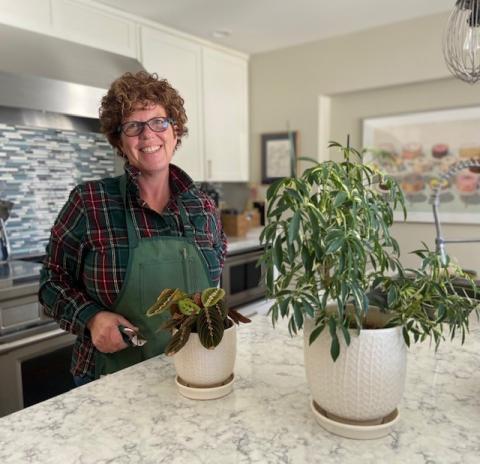Meet Pattie Fried

The Restoration of a Shoreline Park
While Pattie Fried and her husband ran a restaurant/bakery in Hanover, her time for gardening was limited to tending the quaint window boxes outside the restaurant. But once she retired, Pattie knew how she wanted to spend her newfound free time. Gardening fit perfectly within the limitations of the COVID pandemic and being the mother of a special-needs adult daughter. As serendipity would have it, the Fall 2020 Master Gardener class was nearby, in Holderness. As she describes it, Pattie “jumped down the rabbit hole.”
Sitting in that first class, she worried that the rabbit hole was way over her head! But soon she was focusing on invasive plants and enjoying sharing her knowledge with her daughter. In search of Master Gardener internship opportunity near her home in Enfield, she learned about the Mascoma Lakeside Park Committee. The committee had successfully raised funds to purchase the 3-acre lot from the NH DOT in order to keep it a public park. But it needed a lot of work.
Mascoma Lakeside Park comprises a shoreline area with a ramp for non-motorized boats and a meadow bordered by the Northern Rail Trail. On her first visit, Pattie recognized Multiflora Rose – a particularly nasty invasive. Pattie knew that clearing these plants out, along with other invasives, would be a difficult undertaking, but she would soon learn that there were more challenges to this restoration project than removing plants.
Being close to the water, everything required a lengthy approval and permitting process. In order to protect the shoreline and lake, plant control efforts would have to be entirely mechanical — physical removal only. No motorized tools, chemical or biological methods.
Pattie needed landscape drawings, plans and patience. She also needed help from someone with plenty of experience. Patti contacted Emma Erler, a landscape and field specialist with UNH Extension, who advised her to start by getting rid of the invasives. Pattie planned a workday and borrowed tools from the Upper Valley Trail Alliance Tool Library. “Good tools and good food contributed to everyone leaving that first day feeling great,” Pattie explains.
Still dealing with COVID, the twelve volunteers worked in small groups and wore masks. Many of them came through corporate volunteering from Dartmouth College, Hypertherm Inc, and local banks where Pattie had contacts from her lifelong involvement as a local business owner and volunteer.
Lessons learned: Have someone whose job is to take pictures and be ready for pushback. One well-meaning commenter on a local listserv saw the park right after that first workday and described what he saw as, “A very sad day at Mascoma Park!” Pattie was hurt that all of the hard work everyone had contributed that day was being misrepresented as wanton destruction. The next day she carefully responded with reassurance that they would be replacing everything with native plants. “I learned the hard way how important it is to keep the community apprised of what we are doing.”
The second workday, with the help of a $2,000 grant from National Love Your Byways and Toyota, they were able to fulfill that promise. Along with additional invasive removal, they redesigned existing beds, spread mulch, and planted Inkberry bushes, lupines and other natives, along with 1500 naturalized bulbs. Thirty-five volunteers used augers and teamwork to set the stage for a magnificent awakening this spring. She returned to the site in November, to plant a large donation from MG intern Bill Weeks of spring and summer flowering bulbs.
While Pattie admits to being embarrassed by the way the park looked after that first workday when they had removed the invasives, she’s giddy with anticipation for the blooming to come. And, with drawings in hand, she’ll be leading volunteers again to add more flower beds, a rain garden… oh, and there’s the Japanese Knotweed they spotted – that’s got to go!
